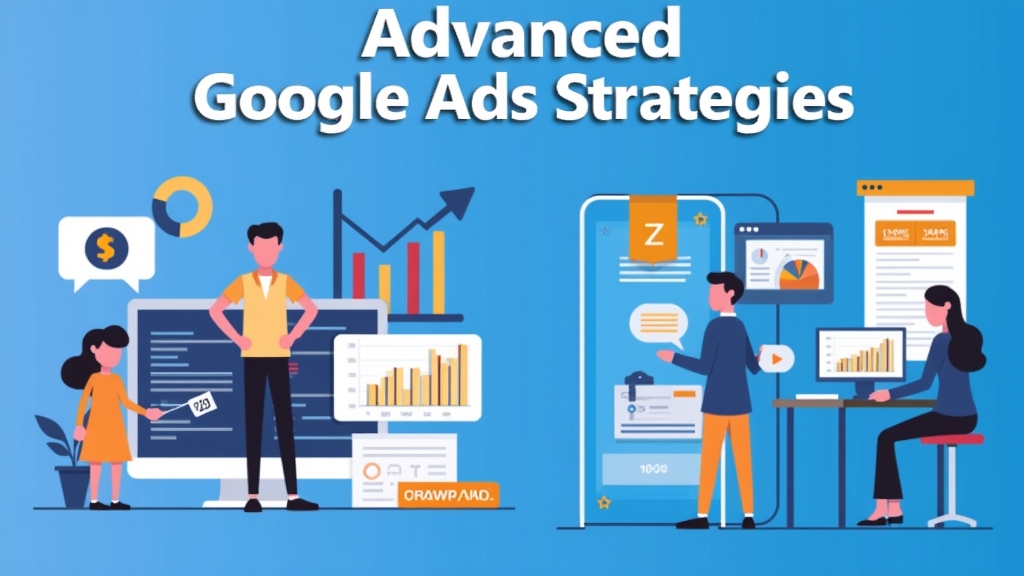Advanced Google Ads Strategies to Elevate Your Marketing Game
Introduction
Understanding the Importance of Google Ads in Modern Marketing
In today’s digital landscape, Google Ads is a powerful tool for businesses looking to reach their audience effectively. With millions of searches happening every day, your potential customers are just a click away. Utilizing Google Ads allows you to showcase your products or services right when users are searching for them. This targeted approach not only boosts visibility but also drives traffic and conversions. By mastering advanced strategies, you can elevate your marketing game and achieve impressive results.
Developing a Comprehensive Google Ads Strategy
Setting Clear Goals and KPIs
Before diving into Google Ads, it’s essential to set clear goals and key performance indicators (KPIs). What do you want to achieve? Whether it’s increasing website traffic, generating leads, or boosting sales, having specific objectives helps guide your campaign. For example, if your goal is to increase sales by 20% over three months, this becomes your benchmark. KPIs like click-through rates (CTR), conversion rates, and return on ad spend (ROAS) will help measure success.
Identifying Your Target Audience
Knowing who your target audience is crucial for effective advertising. Start by creating buyer personas based on demographics such as age, gender, location, interests, and online behavior. Use tools like Google Analytics to gather insights about visitors on your website. This information helps tailor ads that resonate with potential customers. The more accurately you define your audience, the better you’ll be able to craft messages that engage them.
Advanced Targeting Techniques
Utilizing Customer Match for Personalized Campaigns
Customer Match is an advanced targeting feature that allows you to upload lists of email addresses from existing customers or leads into Google Ads. This enables personalized campaigns tailored specifically for these users. For instance, if someone has previously purchased from you but hasn’t returned in a while, you can create targeted ads encouraging them to come back with special offers or new products they might like.
Implementing Remarketing Strategies to Re-Engage Visitors
Remarketing is another effective strategy that targets users who have previously interacted with your website but did not convert. By showing tailored ads across various platforms after they’ve left your site, you remind them of what they’re missing out on. For example, if someone looked at shoes on your site but didn’t buy them; remarketing could show those shoes again along with similar styles or discounts.
Crafting Compelling Ad Copy and Creative
Best Practices for Writing Engaging Headlines and Descriptions
Your ad copy plays a significant role in attracting clicks and conversions. Start with strong headlines that grab attention—use action words or ask questions relevant to the user’s needs. Keep descriptions concise yet informative; highlight unique selling points and include calls-to-action (CTAs) like “Shop Now” or “Learn More.” Testing different variations can help identify what resonates best with your audience.
The Role of Visual Assets in Ad Performance
Visual assets such as images or videos enhance ad performance significantly because they capture attention quickly. High-quality visuals should align with the message you’re conveying in the text portion of the ad—this creates a cohesive experience for viewers. Consider using infographics or short video clips that explain complex ideas simply; this can lead to higher engagement rates.
Optimizing Campaigns for Maximum ROI
A/B Testing: Experimenting with Different Approaches
A/B testing involves comparing two versions of an ad against each other to see which performs better regarding CTRs or conversions. You might test different headlines or images within the same campaign contextually related but varied enough to yield insightful data about preferences among audiences.
Analyzing Performance Metrics and Making Data-Driven Adjustments
Regularly analyzing performance metrics allows you to make informed decisions about adjustments needed within campaigns actively running on Google Ads platforms—look at CTRs alongside conversion rates closely! If something isn’t working well according strictly defined KPIs established earlier during planning phases then pivot accordingly!
Leveraging Automation and Smart Bidding Strategies
Understanding Automated Rules and Scripts
Automation simplifies many aspects of managing campaigns by allowing predefined rules/scripts trigger actions automatically based upon specified conditions being met—for instance pausing underperforming keywords until further analysis occurs later down line! Familiarize yourself thoroughly before implementation so everything runs smoothly without hiccups!
Exploring Smart Bidding Techniques for Better Results
Smart bidding techniques utilize machine learning algorithms designed optimize bids automatically based upon likelihood achieving desired outcomes—this includes maximizing conversions while minimizing costs per acquisition! These methods save time while ensuring competitive edge remains intact throughout ongoing market fluctuations!
Keeping Up with Google Ads Trends and Updates
Staying Informed on Algorithm Changes
Google frequently updates its algorithms affecting how ads appear across search results pages; staying informed ensures strategies remain relevant amidst shifting landscapes! Subscribe newsletters/blogs dedicated providing insights latest trends impacting PPC advertising space directly influence overall effectiveness campaigns run through platform itself!
Adapting to New Features and Tools
New features/tools introduced regularly enhance capabilities available advertisers utilizing platform fully leverage opportunities presented therein! Regularly explore these updates familiarize yourself benefits offered adapting accordingly ensure optimal utilization resources provided continuously evolving environment surrounding digital marketing efforts undertaken daily basis!
Conclusion
Recap of Key Strategies for Successful Google Ads Marketing
To elevate your marketing game using Google Ads effectively requires comprehensive strategies including setting clear goals/KPIs identifying target audiences employing advanced targeting techniques crafting compelling copy optimizing campaigns leveraging automation keeping up trends/updates—all vital components contributing overall success achieved through diligent execution plans laid forth initially crafted together thoughtfully aligned objectives pursued earnestly towards achieving desired outcomes ultimately realized over time invested wisely throughout process undertaken diligently moving forward confidently navigating complexities inherent within realm digital advertising today!
📢 Explore More: Continue Your Journey!
If this article helped you understand advanced strategies in Google Ads marketing better than ever before check out The Ultimate Guide To Keyword Research! It covers essential tips helping refine keyword selection processes enhancing overall campaign effectiveness significantly.














![NEEWER 55W 18"/45cm Ring Light Kit [New Version], 5600K Dimmable ...](https://m.media-amazon.com/images/I/414QLqvZWLL.jpg)








